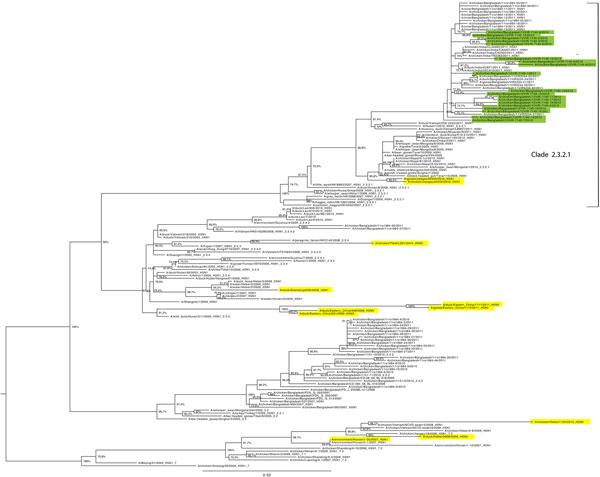Volume 19, Number 10—October 2013
Dispatch
Reassortant Avian Influenza A(H5N1) Viruses with H9N2-PB1 Gene in Poultry, Bangladesh
Figure 1

Figure 1. . Maximum-likelihood phylogenetic tree for the hemagglutinin gene segment of avian influenza (H5N1) viruses from Bangladesh compared with other viruses. Green shading indicates viruses from Bangladesh sequenced and characterized in this study; yellow shading indicates previously described subtype H5N1/H9N2 reassortant influenza viruses (8,9) or those from GenBank. Numbers at the nodes represent bootstrap values. Scale bar indicates nucleotide substitutions per site.
References
- Office International des Epizooties (OIE). Outbreaks of highly pathogenic avian influenza (subtypeH5N1) in poultry notified to the OIE from the end of 2003 to 11 April 2013. 2013 [cited 2013 May 26]. http://www.oie.int/fileadmin/Home/eng/Animal_Health_in_the_World/docs/pdf/graph_avian_influenza/graphs_HPAI_26_05_2013.pdf
- ProMED-Mail. Avian influenza, human (36): H5N1 Bangladesh, fatal. 2013 Apr 8 [cited 2013 Apr 8]. http://www.proMEDmail.org, archive no. 20130408.1631313.
- Negovetich NJ, Feeroz MM, Jones-Engel L, Walker D, Alam SM, Hasan K, Live bird markets of Bangladesh: H9N2 viruses and the near absence of highly pathogenic H5N1 influenza. PLoS ONE. 2011;6:e19311. DOIPubMedGoogle Scholar
- Ahmed SS, Themudo GE, Christensen JP, Biswas PK, Giasuddin M, Samad MA, Molecular epidemiology of circulating highly pathogenic avian influenza (H5N1) virus in chickens, in Bangladesh, 2007–2010. Vaccine. 2012;30:7381–90. DOIPubMedGoogle Scholar
- Monne I, Ormelli S, Salviato A, De Battisti C, Bettini F, Salomoni A, Development and validation of a one-step real-time PCR assay for simultaneous detection of subtype H5, H7, and H9 avian influenza viruses. J Clin Microbiol. 2008;46:1769–73. DOIPubMedGoogle Scholar
- Cattoli G, Monne I, Fusaro A, Joannis TM, Lombin LH, Aly MM, Highly pathogenic avian influenza virus H5N1 in Africa: a comprehensive phylogenetic analysis and molecular characterization of isolates from 2006 to early 2008. PLoS ONE. 2009;4:e4842. DOIPubMedGoogle Scholar
- Guindon S, Gascuel O. A simple, fast, and accurate algorithm to estimate large phylogenies by maximum likelihood. Syst Biol. 2003;52(Suppl 5):696–704. DOIPubMedGoogle Scholar
- Zhao G, Gu X, Lu X, Pan J, Duan Z, Zhao K, Novel reassortant highly pathogenic H5N2 avian influenza viruses in poultry in China. PLoS ONE. 2012;7:e46183. DOIPubMedGoogle Scholar
- Zhao S, Suo L, Jin M. Genetic characterization of a novel recombinant H5N2 avian influenza virus isolated from chickens in Tibet. J Virol. 2012;86:13836–7. DOIPubMedGoogle Scholar
- Nagarajan S, Tosh C, Smith DK, Peiris JS, Murugkar HV, Sridevi R, Avian influenza (H5N1) virus of clade 2.3.2 in domestic poultry in India. PLoS ONE. 2012;7:e31844. DOIPubMedGoogle Scholar
- Li KS, Guan Y, Wang J, Smith GJ, Xu KM, Duan L, Genesis of a highly pathogenic and potentially pandemic H5N1 influenza virus in eastern Asia. Nature. 2004;430:209–13. DOIPubMedGoogle Scholar
- Chen H, Smith GJ, Li KS, Wang J, Fan XH, Rayner JM, Establishment of multiple sublineages of H5N1 influenza virus in Asia: implications for pandemic control. Proc Natl Acad Sci U S A. 2006;103:2845–50. DOIPubMedGoogle Scholar
- Gu M, Liu W, Cao Y, Peng D, Wang X, Wan H, Novel reassortant highly pathogenic avian influenza (H5N5) viruses in domestic ducks, China. Emerg Infect Dis. 2011;17:1060–3. DOIPubMedGoogle Scholar
- Gu M, Huang J, Chen Y, Chen J, Wang X, Liu X, Genome sequence of a natural reassortant H5N2 avian influenza virus from domestic mallard ducks in eastern China. J Virol. 2012;86:12463–4. DOIPubMedGoogle Scholar
- Mondal SP, Tardif-Douglin D, Ryan-Silva R, Magnani R. Controlling highly pathogenic avian influenza, Bangladesh. Emerg Infect Dis. 2012;18:2083–5. DOIPubMedGoogle Scholar
Page created: September 16, 2013
Page updated: September 16, 2013
Page reviewed: September 16, 2013
The conclusions, findings, and opinions expressed by authors contributing to this journal do not necessarily reflect the official position of the U.S. Department of Health and Human Services, the Public Health Service, the Centers for Disease Control and Prevention, or the authors' affiliated institutions. Use of trade names is for identification only and does not imply endorsement by any of the groups named above.